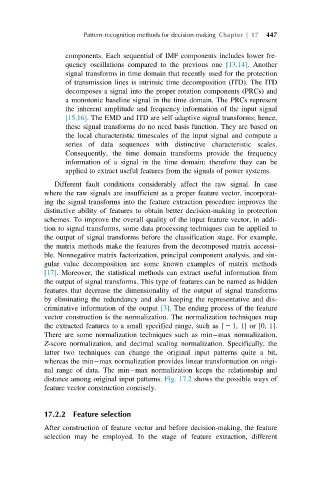Page 487 - Decision Making Applications in Modern Power Systems
P. 487
Pattern-recognition methods for decision-making Chapter | 17 447
components. Each sequential of IMF components includes lower fre-
quency oscillations compared to the previous one [13,14]. Another
signal transforms in time domain that recently used for the protection
of transmission lines is intrinsic time decomposition (ITD). The ITD
decomposes a signal into the proper rotation components (PRCs) and
a monotonic baseline signal in the time domain. The PRCs represent
the inherent amplitude and frequency information of the input signal
[15,16]. The EMD and ITD are self-adaptive signal transforms; hence,
these signal transforms do no need basis function. They are based on
the local characteristic timescales of the input signal and compute a
series of data sequences with distinctive characteristic scales.
Consequently, the time domain transforms provide the frequency
information of a signal in the time domain; therefore they can be
applied to extract useful features from the signals of power systems.
Different fault conditions considerably affect the raw signal. In case
where the raw signals are insufficient as a proper feature vector, incorporat-
ing the signal transforms into the feature extraction procedure improves the
distinctive ability of features to obtain better decision-making in protection
schemes. To improve the overall quality of the input feature vector, in addi-
tion to signal transforms, some data processing techniques can be applied to
the output of signal transforms before the classification stage. For example,
the matrix methods make the features from the decomposed matrix accessi-
ble. Nonnegative matrix factorization, principal component analysis, and sin-
gular value decomposition are some known examples of matrix methods
[17]. Moreover, the statistical methods can extract useful information from
the output of signal transforms. This type of features can be named as hidden
features that decrease the dimensionality of the output of signal transforms
by eliminating the redundancy and also keeping the representative and dis-
criminative information of the output [3]. The ending process of the feature
vector construction is the normalization. The normalization techniques map
the extracted features to a small specified range, such as [ 2 1, 1] or [0, 1].
There are some normalization techniques such as min max normalization,
Z-score normalization, and decimal scaling normalization. Specifically, the
latter two techniques can change the original input patterns quite a bit,
whereas the min max normalization provides linear transformation on origi-
nal range of data. The min max normalization keeps the relationship and
distance among original input patterns. Fig. 17.2 shows the possible ways of
feature vector construction concisely.
17.2.2 Feature selection
After construction of feature vector and before decision-making, the feature
selection may be employed. In the stage of feature extraction, different

